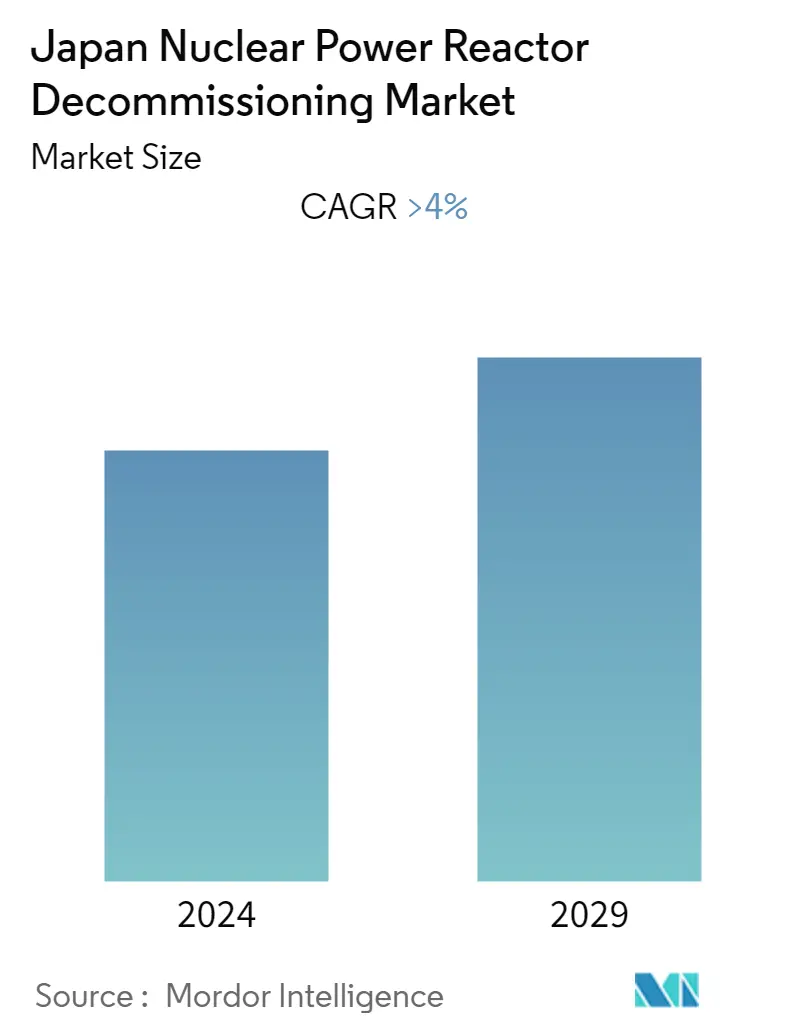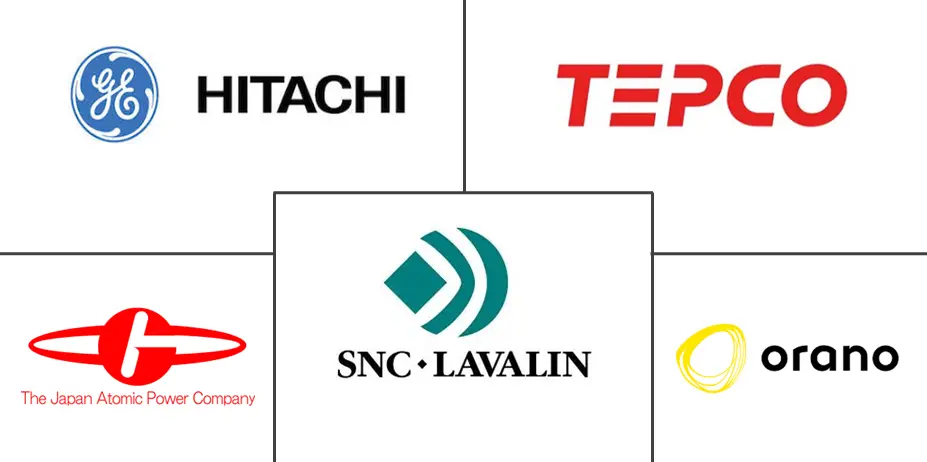Market Size of Japan Nuclear Power Reactor Decommissioning Industry

| Study Period | 2020 - 2029 |
| Base Year For Estimation | 2023 |
| Forecast Data Period | 2024 - 2029 |
| Historical Data Period | 2020 - 2022 |
| CAGR | 4.00 % |
| Market Concentration | Medium |
Major Players
*Disclaimer: Major Players sorted in no particular order |
Japan Nuclear Power Reactor Decommissioning Market Analysis
The Japan Nuclear Power Reactor Decommissioning Market is expected to rise at a CAGR of more than 4% during the forecast period.
COVID-19 negatively impacted the market in 2020. Presently the market has reached pre-pandemic levels.
In The long term, increasing penetration of renewable energy sources such as solar and wind, which produce cleaner and more economical energy, are expected to drive the market during the forecasted period.
On the other hand, the high cost of decommissioning plants and few numbers of mature power plants are major restraints expected to hinder the market's growth during the forecasted period.
Moreover, the increasing usage of robots and artificial intelligence for plant decommissioning is expected to create significant opportunities for the Japan Nuclear Power Reactor Decommissioning Market.
Japan Nuclear Power Reactor Decommissioning Industry Segmentation
Decommissioning nuclear power plants are the process of removing all the fuel in that nuclear power station. Shutting down the plans and all the facilities and restoring the site to a pre-agreed state so the land can be reutilized for other activities. The dismantling is done so that no more protection is required against the radiation.
The Japan nuclear power reactor decommissioning market is segmented by Reactor Type, Application, and Capacity. By reactor type, the market is segmented into Pressurized Water Reactor, Pressurized Heavy Water Reactor, Boiling Water Reactor, High-temperature Gas-cooled Reactor, Liquid Metal Fast Breeder Reactor, and Other Reactor Types. By Application, the market is segmented into Commercial Power Reactors, Prototype Power Reactors, and Research reactors. By Capacity, the market is segmented below 100 MW, 100-1000 MW, and Above 1000 MW. For each segment, the market sizing and forecasts have been done based on revenue (USD Billions) for all the above segments.
| Reactor Type | |
| Pressurized Water Reactor | |
| Pressurized Heavy Water Reactor | |
| Boiling Water Reactor | |
| High-temperature Gas-cooled Reactor | |
| Liquid Metal Fast Breeder Reactor | |
| Other Reactor Types |
| Application | |
| Commercial Power Reactor | |
| Prototype Power Reactor | |
| Research Reactor |
| Capacity | |
| Below 100 MW | |
| 100-1000 MW | |
| Above 1000 MW |
Japan Nuclear Power Reactor Decommissioning Market Size Summary
The Japan Nuclear Power Reactor Decommissioning Market is poised for growth, driven by the increasing shift towards renewable energy sources like solar and wind, which offer cleaner and more cost-effective energy solutions. Despite the initial setbacks caused by the COVID-19 pandemic, the market has rebounded to pre-pandemic levels. However, the high costs associated with decommissioning and the limited number of mature power plants present challenges to market expansion. The integration of advanced technologies such as robotics and artificial intelligence in the decommissioning process is anticipated to open new avenues for growth. The commercial nuclear power plants, which are integral to Japan's national energy grid, are expected to dominate the market during the forecast period, especially as the country continues to phase out nuclear power in favor of renewable energy.
Japan's renewable energy sector is expected to experience significant growth, supported by government initiatives aimed at transitioning to cleaner energy sources and advancements in renewable technologies. The country's commitment to achieving carbon neutrality has led to ambitious targets for increasing the share of renewables in its energy mix. This shift is further bolstered by projects like the deployment of solar power capacity for the NTT Group, which exemplifies the growing trend towards renewable energy solutions. As Japan continues to enhance its renewable energy infrastructure, the decommissioning market for nuclear power reactors is likely to benefit from this transition, with key industry players actively involved in the decommissioning efforts.
Japan Nuclear Power Reactor Decommissioning Market Size - Table of Contents
-
1. MARKET OVERVIEW
-
1.1 Introduction
-
1.2 Market Size and Demand Forecast in USD billion, till 2028
-
1.3 Recent Trends and Developments
-
1.4 Government Policies and Regulations
-
1.5 Market Dynamics
-
1.5.1 Drivers
-
1.5.2 Restraints
-
-
1.6 Supply Chain Analysis
-
1.7 PESTLE Analysis
-
-
2. MARKET SEGMENTATION
-
2.1 Reactor Type
-
2.1.1 Pressurized Water Reactor
-
2.1.2 Pressurized Heavy Water Reactor
-
2.1.3 Boiling Water Reactor
-
2.1.4 High-temperature Gas-cooled Reactor
-
2.1.5 Liquid Metal Fast Breeder Reactor
-
2.1.6 Other Reactor Types
-
-
2.2 Application
-
2.2.1 Commercial Power Reactor
-
2.2.2 Prototype Power Reactor
-
2.2.3 Research Reactor
-
-
2.3 Capacity
-
2.3.1 Below 100 MW
-
2.3.2 100-1000 MW
-
2.3.3 Above 1000 MW
-
-
Japan Nuclear Power Reactor Decommissioning Market Size FAQs
What is the current Japan Nuclear Power Reactor Decommissioning Market size?
The Japan Nuclear Power Reactor Decommissioning Market is projected to register a CAGR of greater than 4% during the forecast period (2024-2029)
Who are the key players in Japan Nuclear Power Reactor Decommissioning Market?
GE-Hitachi-Nuclear Energy, Ltd., Japan Atomic Power Co., Snc-Lavalin Group Inc (Atkins), Tokyo Electric Power Company Holdings, Inc. and Orano SA are the major companies operating in the Japan Nuclear Power Reactor Decommissioning Market.

